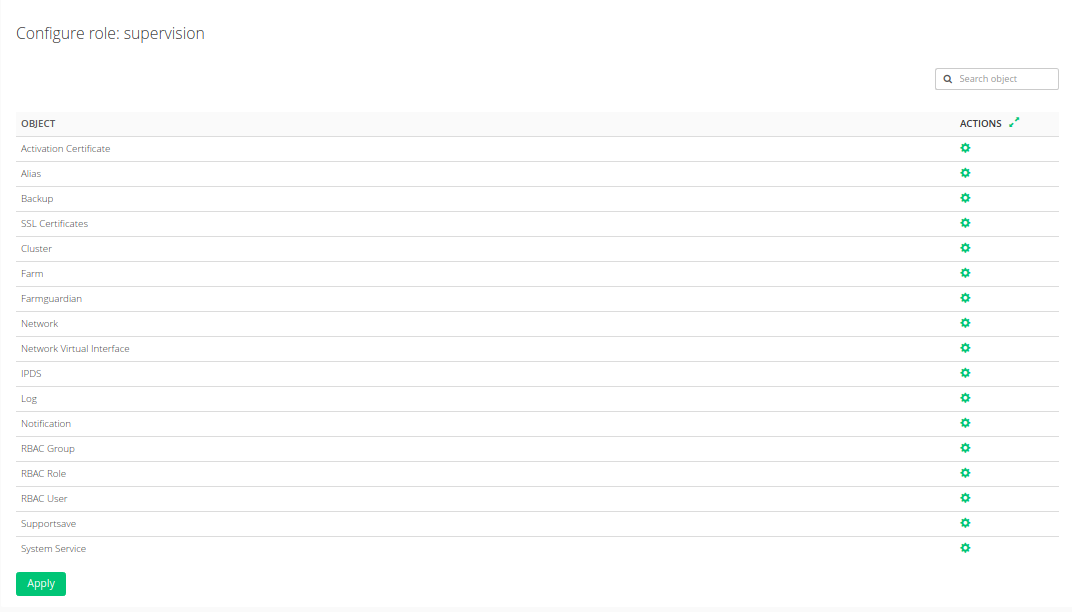From this section you can configure the role, enable or disable permissions of object actions. In this section you can see a table with the available objects.
In this section you can see a group list with the following parameters:
OBJECT. Object to apply it permissions.
ACTIONS. The allowed actions is configure, if you press this icon, a new row appears below the object with distinct actions to configure. If the action is checked, the action for this object is enabled, if is not checked is disabled. This column has a expand icon ![]() to expand all objects, showing all actions of all objects.
to expand all objects, showing all actions of all objects.
Finally, after you check the desired actions for each object, it’s needed to click on the green Apply button in order to apply these changes and a confirmation message will appear at the left bottom corner of the browser.
Objects and their actions
In the following list you can see that each available object has below it the available actions to configure:
Activation Certificate. It defines actions applied to the Zevenet activation certificate.
- Delete. Allows to delete the activation certificate.
- Show. Allows to show the activation certificate.
- Upload. Allows to upload the activation certificate.
Alias. It defines actions to manage the alias feature.
- Delete. Allows to delete alias.
- List. Allows to list alias.
- Modify. Allows to modify alias.
Backup. It defines actions to manage the backups.
- Apply. Allows to apply backups.
- Create. Allows to create backups.
- Delete. Allows to delete backups.
- Download. Allows to download backups.
- Upload. Allows to upload backups.
SSL Certificate. It defines actions to manage the SSL certificates.
- Create. Allows to create SSL certificates.
- Delete. Allows to delete SSL certificates.
- Download. Allows to download SSL certificates.
- Show. Allows to show SSL certificates.
- Upload. Allows to upload SSL certificates.
Cluster. It defines actions to manage the cluster.
- Create. Allows to create the cluster.
- Delete. Allows to delete the cluster.
- Maintenance. Allows to put in maintenance the cluster.
- Modify. Allows to modify the cluster.
Farm. It defines actions to administrate the farms. The user only will be able to manage the farms of the user’s group.
- Action. Allows to execute actions in farms.
- Create. Allows to create farms.
- Delete. Allows to delete farms.
- Maintenance. Allows to put the backends in maintenance.
- Modify. Allows to modify farms.
Farmguardian. It defines actions to manage the farm health checks. To apply a farmguardian to a farm, the required object is farm.
- Modify. Allows to create, modify and delete farmguardian checks.
Network. It defines actions to administrate the network menu. The virtual interfaces are a exception, they are manage by the virtual-interfaces object.
- Modify. Allows to create, modify and delete interfaces not virtual. Also allows to execute actions in interfaces not virtual.
Network Virtual Interface. It defines actions to administrate the virtual interfaces. The user only will be able to manage the interfaces of the user’s group.
- Action. Allows to execute actions in virtual interfaces.
- Create. Allows to create virtual interfaces.
- Delete. Allows to delete virtual interfaces.
- Modify. Allows to modify virtual interfaces.
IPDS. It defines actions to manage the ipds rules. To apply a rule to a farm, the required object is farm.
- Action. Allows to execute actions in IPDS rules.
- Modify. Allows to create, modify and delete IPDS rules.
Log. It defines actions to manage the load balancer logs.
- Download. Allows to download logs.
- Show. Allows to show logs.
Notification. It defines actions to manage notifications: alerts and sent methods.
- Action. Allows to execute actions in the notifications section.
- Modify. Allows to modify the notifications section.
- Show. Allows to show the notifications section.
- Test. Allows to send test email from the notifications section.
RBAC Group. It defines actions to manage the RBAC groups.
- Create. Allows to create RBAC groups.
- Delete. Allows to delete RBAC groups.
- List. Allows to list RBAC groups.
- Modify. Allows to modify RBAC groups.
- Show. Allows to show RBAC groups.
RBAC Role. It defines actions to manage the RBAC roles.
- Create. Allows to create RBAC roles.
- Delete. Allows to delete RBAC roles.
- Modify. Allows to modify RBAC roles.
- Show. Allows to show RBAC roles.
RBAC User. It defines actions to manage the RBAC users.
- Create. Allows to create RBAC users.
- Delete. Allows to delete RBAC users.
- List. Allows to list RBAC users.
- Modify. Allows to modify RBAC users.
- Show. Allows to show RBAC users.
Supportsave. It defines actions to manage the Zevenet supportsave.
- Download. Allows to download support saves.
System Service. It defines actions to manage the remote and the local services.
- Modify. Allows to modify the system services section (System menu >> Local Services and Remote Services).

